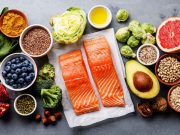It’s certainly obvious, with a quick stroll down the dangerous middle aisles of any grocery store, that a lot of food marketing targets children. (After all, silly rabbit, “Trix are for kids!”) the fake dyes and colors galore that often propagate aggressive and poor behavior (and are banned in Europe) for good reason! It is also no secret that obesity and Type 2 Diabetes rates are skyrocketing in children and appearing at younger and younger ages… Could there be a connection? (Hint: yes!)
While most parents (I hope) agree that basic foods like healthy proteins and green veggies are important staples for the little ones, the issue of child nutrition is hardly cut and dry now. With soccer games, choir practice, chess club, play practice and a social schedule that would have made me dizzy at their ages, most kids these days (and moms) just aren’t home at meal times much. This rapidly paced lifestyle makes it easier to justify quick food, even if it is devoid of nutrients.
Let’s look at some obvious and important guidelines to remember:
Parents buy the food and plan the meals. You decide which foods to purchase and when to serve them. Though kids will pester their parents for less nutritious foods, adults are in charge and decide which foods are regularly stocked in the house. Kids won’t go hungry. They’ll eat what’s available to them. If their favorite snack isn’t all that nutritious, you can still buy it once in a while so they don’t feel deprived. By having fewer junk foods around, you’ll force your children to eat more fruits, vegetables, whole grains, and protein options. Schedule regular meal and snack times. Let them choose what to eat and how much of it they want. This may seem like too much freedom. But if you follow Step 1, your kids will be choosing only from the foods you buy and serve.
Quit the “clean-plate club.” Let kids stop eating when they feel they’ve had enough. Lots of parents grew up under the clean-plate rule, but that approach doesn’t help kids listen to their own bodies when they feel full. When kids notice and respond to feelings of fullness, they’re less likely to overeat. A parent’s job is to decide what’s for dinner; a kid’s job is to decide how much of it to eat. Many parents try to control how much their kids eat, but this just leads to power struggles. Letting kids learn their own satiety signals means they’re less likely to grow up with appetite control issues or disordered eating. If your child is healthy, has energy and is an appropriate weight, don’t waste time worrying about how much they eat at a meal.
Start them young and rewrite the “kids’ menu”. Food preferences are developed early in life, so offer variety. Likes and dislikes begin forming even when kids are babies. You may need to serve a new food a few different times for a child to accept it. Don’t force a child to eat, but offer a few bites. With older kids, ask them to try one bite. Who says kids only want to eat hot dogs, pizza, burgers, and macaroni and cheese? When eating out, let your kids try new foods and they might surprise you with their willingness to experiment.
Drink calories count. Juice, soda, and other sweetened drinks add extra calories and get in the way of good nutrition. Water and quality milk options are the best drinks for kids.
Kids do as you do. Be a role model and eat healthy yourself. When trying to teach good eating habits, try to set the best example possible. Choose nutritious snacks, eat at the table, and don’t skip meals.
Limit TV and computer time. When you do, you’ll avoid mindless snacking and encourage activity. Research has shown that kids who cut down on TV watching also reduced their percentage of body fat. When TV and computer time are limited, they’ll find more active things to do.
OK now what? How can you make this FUN? You know the basics, but who says healthy eating has to be by the book? As a certified, Holistic Health and Nutrition coach and mother of three boys, I’m all for breaking the rules around food. Food represents much more than a bunch of vitamins and minerals. In addition to nourishment, at times it’s alright that it’s fun, a comfort, a celebration, a seasonal treat, a learning opportunity and much, much more. Here are some unearthed, fun ways to get kids to the table — hungry and excited about eating healthy.
Serve dinner for breakfast? Leftover chicken and rice for breakfast? Pancakes for dinner? Well, why not? If it was a healthy, balanced meal last night, it’s still a healthy, balanced meal this morning — and vice versa. So if your kids’ favorite dinner time fare is pizza, make mini-pizzas for breakfast. Just fill pita pockets with tomato sauce, ham, pineapple and cheese, and heat them up; or make fruity pizzas on toasted English muffins with light cream cheese, sliced bananas, berries and grapes. Kebabs are another meal traditionally reserved for dinnertime, but they can be a healthy option all day. My boys all like breakfast kebabs made with cubes of ham or turkey sausage with cheese, strawberries, pineapple, kiwi or cantaloupe chunks — basically anything you can put on a stick.
Get the kids in the kitchen! If kids can make it, they are more likely to eat it. I have one of the pickiest eaters, so I’ve gotten pretty adventurous at coming up with interesting twists to help him eat healthy. My latest is letting both my kids plan and make a meal a week. It’s a little more work, but my seven-year-old just told me he wants to try a cooking camp this summer!
Kids love “build it yourself” meals and dips. Fajitas, salad bars, sandwich bars, potato bars, pizza bars —and fruit ’n’ yogurt parfait bars for dessert. Just set out an array of healthy ingredients and let the kids do the rest. And it’s great for kids of all ages. And kids love dipping things. The dip can be just about anything: yogurt, applesauce, hummus, maple syrup, ketchup, gravy. Dressings, condiments and sauces are also a good way to introduce new tastes.
Play with your food! Mealtimes should be more of a playground than a battleground. Food can be arranged into face shapes, stacked into toothpick towers, or cut up with cookie cutters. Making mealtime fun doesn’t just get kids eating well, it also leaves them with fond memories of food as they grow up.
Go grazing! Most parents overestimate the size of their kids’ stomachs, so small meals and snacks spread over the day are actually better than the “three square meals.” The other advantage to offering smaller meals and two or three snacks in between is that if one meal is a flop, there’s another opportunity for healthy eating just around the corner.
Dress up fruit and veggies! Tired of saying “Eat your vegetables”? Try serving fruit and vegetables in unexpected ways. From fruit/veggie smoothies and yogurt ice pops to sweet potato and zucchini fries, anything out of the ordinary is guaranteed to pique their interest. Also, frozen and canned produce is processed at peak ripeness, so it’s flavorful and high in nutrients when fresh produce isn’t available.
Don’t try so hard. Getting kids to eat healthy should not make you break a sweat. Nutritious meals don’t have to be elaborate. Forget about coaxing, encouraging, threatening or begging. Kids will eat healthy, delicious food if you continue to offer it and they see you eating it. And they’ll learn to eat on their own terms too, which is the key to healthy eating in the long run.
Pizza Rolls with Spinach and Cheese
1 cup chopped spinach
13- 16oz pizza dough
¾ cup pizza sauce
2 cups mozzarella cheese
¼ cup parmesan cheese
-Preheat the oven to 400° F and grease a muffin tin very well, including around the top of each cup since the cheese may spill out a little.
-Use your hands to stretch the dough into an 11×16-inch rectangle on a piece of parchment paper.
-Spread pizza sauce over the dough to cover, then sprinkle on the spinach, mozzarella, and Parmesan. Starting on one long side, roll the dough up carefully and fairly tightly to enclose the toppings. (It might be a little messy, but it’s okay!)
-Use a serrated knife to cut into 12 even slices. I start in the center, then make a cut in the center of each piece, and then finish slicing to get the most even results.
-Place each slice into a prepared muffin cup and bake for 22-26 minutes until the dough is baked through, the cheese is melted, and the tops are golden.
-Let cool for 3-5 minutes in the pan to allow the cheese to firm up slightly, then transfer to a wire rack or a plate to serve. (You may need to use a a knife around the edges of the pan if the cheese spilled over.)
-Store in an airtight container for up to 3 days in the fridge or in a zip-lock freezer bag with as much air removed as possible in the freezer for up to 3 months. To serve from frozen, place on a plate and microwave for 30-60 seconds or until warm.
Blueberry Muffin Smoothie (blend all well and serve)
1 cup milk of choice
1 cup frozen blueberries
1 scoop clean vanilla protein (I swear by my Juice Plus)
1 large handful baby spinach
2 tablespoons almond butter
1 tablespoon coconut flakes
Chocolate Peanut Butter Cup Smoothie (blend all well and serve)
1 banana, frozen
1 cup milk of choice
¼ cup old-fashioned rolled oats
3 tablespoons natural peanut butter or nut butter
1 tablespoon cocoa powder
1 date (softened in warm water prior to blending)
Pinch of salt





































